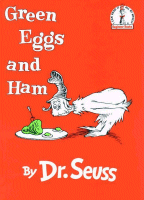 Dr. Seuss‘s Green Eggs and Ham is one of the reasons I do this blog, write books, and am an English professor.  Nearly forty years ago, Green Eggs and Ham — which turns 50 this month — taught me to read.  It also taught me that reading is fun, helping to make me a life-long reader.
Dr. Seuss‘s Green Eggs and Ham is one of the reasons I do this blog, write books, and am an English professor.  Nearly forty years ago, Green Eggs and Ham — which turns 50 this month — taught me to read.  It also taught me that reading is fun, helping to make me a life-long reader.
The book didn’t teach me literacy all by itself, of course.  My parents read to me.  And I watched both Sesame Street and The Electric Company on PBS. But Green Eggs and Ham helped me put what I learned into practice.  The poetry and the limited vocabulary were key.
Seuss used a restricted vocabulary for his Beginner Books: since these were designed to teach reading, the idea was not to overwhelm a child with too many different words. The Cat in the Hat (1957) had 236 different words. He found the requirement of writing within word limits very challenging. He’d agreed to write a book that would teach children to read, but felt stymied. His favorite story about writing The Cat in the Hat is that, when about to give up in frustration after having written a story about a queen zebra (only to find neither word on the word list), he looked at the list of 348 different words provided by the publisher, and decided that he would find two words that rhyme: he found “cat” and “hat” and decided to make The Cat in the Hat the title of his book.  As is the case with many of Seuss’s stories, that’s not strictly true. When talking to the press, he was often more interested in telling a good story than in telling an accurate one.  In truth, images came easier to him than words did.  And the earliest story he told about the creation of The Cat in the Hat is likely the accurate one: in that version, he came across a sketch of a cat wearing a hat, found both words on the list, and made that the book’s title.
When, a few years later, his publisher bet him that he couldn’t write a book using 50 or fewer different words, Seuss’s response was Green Eggs and Ham. Â For a beginning reader (such as I was), this is ideal because you encounter the same word many times. Â The first time you see the word — house, mouse, fox, box — you have to sound it out, and Seuss’s end rhymes give you clues to pronunciation. Â Subsequent times, seeing the word offers a sense of mastery. Â I remember myself at three years old, experiencing such joy as the difficult words quickly became much easier. Â When I finished reading Green Eggs and Ham — the first time I had read a book all by myself — I was so happy that I flipped the book back over to the front cover, and began to read again.
I’ve been talking a bit to people about Green Eggs and Ham lately – The Arena on Ireland’s RTE Radio 1 in July, and Breakfast with Red Symons on 774 ABC Melbourne (Australia) last week.  Tomorrow (Tuesday evening in Kansas, Wednesday morning in Australia), I’m on 720 ABC Perth’s Breakfast with Eoin Cameron. It’s been fun talking about the book, and about Seuss. But those do not seem the venues in which to share what the book means to me, personally. So, I’m writing about it here.  In teaching me not only how to read but why, Green Eggs and Ham helped make me a reader, which in turn led me to become an English major, and finally an English Ph.D… who happens to specialize in Children’s Literature.

Toby Speed
Philip Nel
Pingback: kids Book » On the 50th Birthday of "Green Eggs and Ham"
Pingback: kidsBookSite.com » On the 50th Birthday of "Green Eggs and Ham"
Sigga
Pingback: A Seusstastical Celebration | All About Autism
Pingback: Dr. Seuss